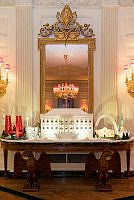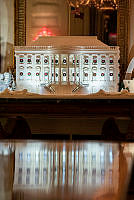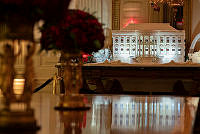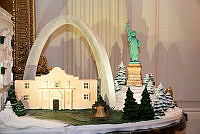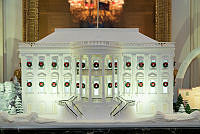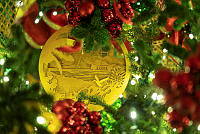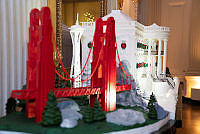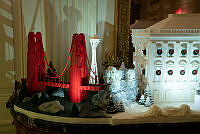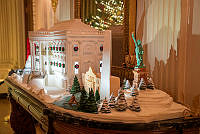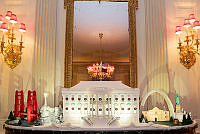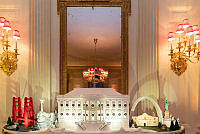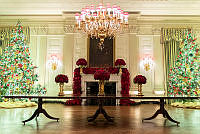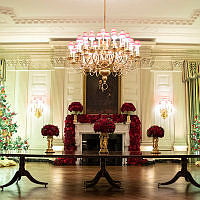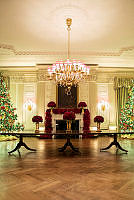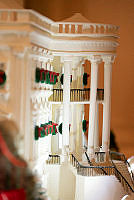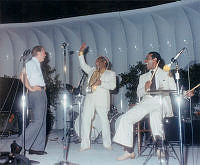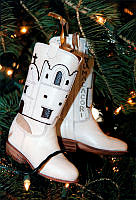The “American Resolve” Behind the Scenes
Copyright © September 1, 2021 White House Historical Association. All rights reserved under international copyright conventions. No part of this article may be reproduced or utilized in any form or by any means, electronic or mechanical, including photocopying, recording, or by any information storage and retrieval system, without permission in writing from the publisher. Requests for reprint permissions should be addressed to books@whha.org

On the morning of September 12, 2001, hundreds of men and women showed their badges at the White House gates as they reported to work.

They were following their daily routines, just as they had the previous day on September 11, 2001. Flowing through the gates were presidential aides and appointees, the first lady’s staff, White House correspondents, photographers, chefs, interns, curators, ushers, butlers, florists, engineers, housekeepers, groundskeepers, calligraphers, and others.
In the intervening twenty-four hours many had watched live coverage of the terrorist attacks in New York on televisions throughout the White House complex, many had heard and even felt the impact when a hijacked passenger plane slammed into the Pentagon, and all had been ordered to run if they “wanted to live.”


They had seen the smoke fill the air above Washington and felt relief when military jets arrived to protect the White House—which was not only their workplace, but likely an imminent target. They had navigated evacuating crowds of Washingtonians and tourists, worried about their loved ones when cell phones failed, and cemented bonds with colleagues, all the while keeping their obligation to support the president first and foremost in their minds.

White House History Quarterly chose the twentieth anniversary of September 11, 2001, to look back, going behind the scenes at the White House and on Air Force One, on that singular day in the history of the President’s House, when the staff was suddenly confronted with the possibility that the house, along with their lives, could be lost within minutes. The Quarterly is honored to share their many unknown stories, publishing the accounts for the first time in this issue.
White House Employees Remember September 11, 2001

Beginning in 2002, Donna Hayashi Smith (above), associate curator of collections and registrar in the Office of the Curator, compiled the memories of her colleagues who serve on the Executive Residence staff.

Using the accounts shared with her by her White House colleagues, Hayashi Smith provides an account of the aftermath of the evacuation order writing, "Administrative Assistant Claire Faulkner remembered the moment when Walters telephoned her from the South Grounds: 'As I was watching the Pentagon on TV, [Chief Usher] Gary Walters called me and said, Claire, get out of the House. Get everyone out of the House that you can find, and run towards the south. . . I don’t know if I was ever really afraid of dying . . . I was more afraid of actually losing the White House.' Twenty years ago only Executive Residence supervisors carried government-issued cell phones; many staff carried pagers, but not all. Two-way radios were used mainly by electricians and the engineers. There were no complex-wide emergency radios. Because staff members were working in different areas of the White House and Grounds and not everyone had communication devices, widespread emergency evacuation notification was difficult. Most staff received notice by word-of-mouth, and some by landline and mobile phone. Executive Pastry Chef Roland Mesnier repeatedly tried calling his staff working in the Pastry Shop but received a busy signal because someone was on the phone. A Secret Service UD officer finally reached the Pastry Shop after Chef Mesnier was forced to evacuate. His tall chef’s toque helped his staff identify and reunite with him and the rest of the Pastry Shop staff at Lafayette Park. Nancy Clarke, the chief floral designer, went to the Usher’s Office and found Claire Faulkner sitting alone. Faulkner said, 'Nancy, evacuate. Just run. Get out of here. Tell everyone to get out of here that you see.' As Clarke returned to the Flower Shop, a Secret Service officer in the hallway said, 'Go! Go! Just get out the door. Get out the door.' Clarke recalled, I said, ‘Well, can I at least go get my purse?’ He said, ‘Oh, no, no. Just go.' Houseman Willie Murchison was sitting in the men’s locker room with colleagues Ben Morrow and Lindsey Little when they learned on TV that the White House had been evacuated. Murchison recalled, 'It said the White House had been evacuated, and we all looked at each other like, This can’t be, because we’re still in here.’"
Hayashi Smith also writes about the security changes that later followed, "safety procedures were developed and security policies improved. An emergency response committee was established to address procedures and preparedness. This small group unified and empowered staff to make changes and improvements for all emergencies. Public tours and events hosted by President and Mrs. Bush ceased for many weeks. East Executive Avenue and the Ellipse were closed to the public. New steel plate barriers to control vehicular traffic appeared. Soon after September 11, procedures were changed to require every visitor that enters the White House for a tour to undergo a Secret Service background clearance." She concludes her article by observing, "Through the day of September 11 and the year thereafter, the Residence staff remained steadfast in their sense of duty and commitment to the president and first lady and the White House itself. Buddy Carter said, 'But, we’re here to take care of the president and first lady. That’s our job. That’s our obligation.'”
The Evacuation of the Executive Office of the President

Anita McBride, (above) who was then a special assistant to the president, shares the stories of the Executive Office of the President staff, who regrouped following the evacuation and continued to carry out their duties. She writes, "Just as the White House morning routines were beginning, the Secret Service ordered an evacuation of the entire Executive Office of the President complex. That meant the approximately 1,800 staff working in the East and West Wings of the White House, the Old Executive Office Building (now the Eisenhower Executive Office Building), the New Executive Office Building, and the Winder Building a block away had to leave as quickly as possible. Women were advised to kick off their heels and run for their lives. The shocking experience had little precedent in White House history. When the editor of White House History Quarterly decided to devote an issue to the twentieth anniversary of 9/11, she knew that I had been on the EOP staff at the time and she asked that I capture the memories of the staff from across the EOP complex to add to the well-documented accounts of the president and other senior officials. Prefaced by an account of the activities of President and Mrs. George W. Bush and Vice President Dick Cheney on the morning of 9/11, the stories were gathered through interviews and published reports and provide a record of what staff from the West Wing, East Wing, and Old Executive Office Building experienced on September 11, 2001. The memories come from a wide range of staffers, from aides assisting the vice president and the National Security Council with the weightiest of responsibilities to the class of young fall interns from around the country who had just started their first full day at the White House.

Although each story is unique, an unmistakable theme runs through them all: the people entrusted with the privilege of service at the White House were determined to fulfill their duties and to do whatever it took to get back to work on behalf of the president and the country."
The Evacuation of the President

The Quarterly is also pleased to include the story of September 11, 2001, through the unique experience of White House correspondent Ann Compton (above) who documented the president’s journey as he led the nation not from the ground, but from the White House in the sky, Air Force One. She explains "Doomsday planning for the U.S. Government—the protection of the president, the civilian chain of command, the use of force by the military—leaves nothing to chance. Real crises can play havoc with those plans. One did on September 11, 2001. I was there. By that date I had covered six presidents over an arc of twenty-five years for ABC News, and by chance that sunny Tuesday was my turn as press pool correspondent to cover the president’s flight back to Washington, D.C."

Compton tells the dramatic story of her unexpected journey west on Air Force One during the hours when it was deemed too dangerous for the president to return as planned from Florida to the White House. "For its own safety, Air Force One had been circling somewhere along the Gulf Coast. Watching the weak TV reception, we were all stunned at the sight of the towers collapsing, horrified at the innocent loss of life in New York and Washington. In the skies, I never felt we and the president were in danger, but Col. Tillman at the controls took nothing for granted. We learned later there might have been a threatening call to the White House switchboard warning, 'Angel is next.' Angel is the code name for Air Force One.... At 11:31 a.m. ET Press Secretary Ari Fleischer came to the press cabin. His grave statement to the travel pool made my heart stop: 'The president is being evacuated.' He said that is off-the-record, meaning it could not be shared with the public. I protested that such a profound decision is much too important to keep secret. For history! But then I looked out the windows, where jet fighters held their positions just off each wingtip. I realized I had no way to share that dramatic development with the world, even if I wanted to."

At times Ann Compton did not even know where she was going. "Beneath each television monitor embedded in the bulkhead wall there are three digital clocks. In green LED displays the first is labeled WASHINGTON. The second is LOCAL. The third time says DESTINATION. As Air Force One began to roll, the first two clocks read 1:36 p.m. The DESTINATION numerals changed in a snap to 12:36 p.m. Central time. It was our only official confirmation that the president was being flown west, away from Washington. The president was being evacuated."
Compton concludes the article with an account of the President's later return to Washington. "We crossed the Blue Ridge Mountains as the sunlight faded on a day that had been so mild and clear all across the United States. The aircraft made a slow, full circle—probably not too far south of the spot where the fourth plane crashed in Pennsylvania—before we descended to the land at Andrews Air Force Base. Marine One was on the tarmac as usual, ready to whisk the president fast to the White House South Lawn. For the only time in memory, there was a second helicopter to take our small press travel pool down along the same river route to land in a golden sunset at 7:00 p.m. on the lawn of the Washington Monument, just outside the White House gates. We saw the same scene President Bush saw as he flew across the deserted capital. It was his first real glimpse of the shock and reality of that day—the thick black smoke rising from the ruins of the Pentagon’s gaping wound. America under attack."
Providing Comfort at Camp David
Chef Matthew Wendel provides a different perspective to the Quarterly with his account of preparing food for the president and his staff at Camp David the weekend of September 15, 2021.

He writes, "Mrs. Bush wanted to have a simple menu like burgers and fried chicken—comfort foods of a sort. The president would first travel to New York City to see the devastation of the World Trade Center, and once at Camp David he would meet with Secretary of State Colin Powell, Secretary of Defense Donald Rumsfeld, Vice President Dick Cheney, and many other top officials. The whole world had changed. And, like the rest of America, I was unsure of the future. . . . At Camp David, the guests eat at one large table. Meals are served family style. Mrs. Bush’s choice of comfort foods for that weekend aimed to ease some of the stress and sadness that everyone was feeling. I had never expected anything like an attack on our nation to happen, and now I was to prepare and serve foods that would not only comfort but sustain the people who were making the hardest decisions of their lives, decisions that would affect our country forever."
In his televised address to the nation delivered at 8:30 p.m. President Bush announced that government offices in Washington would reopen for all workers on September 12. He called for prayers for the families of the thousands whose “lives were suddenly ended by evil. And he continued, “These acts shatter steel, but they cannot dent the steel of American resolve.” That American resolve is defined in the experiences witnessed and documented by Ann Compton, Anita McBride, Donna Hayashi Smith, and Matthew Wendel. Their accounts underscore the courage and dedication to service of those who reentered the gates and returned to service at the White House.




